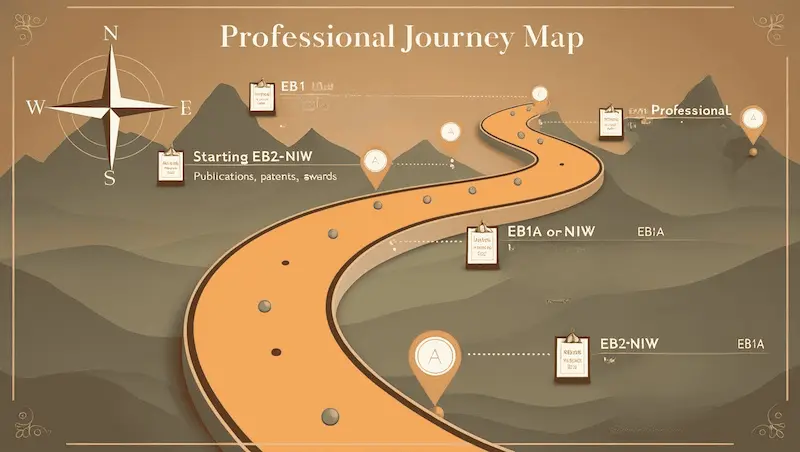Last summer, we virtually sat across from Elena, a brilliant neuroscientist from Brazil, as she spread her credentials across her desk. With tears welling in her eyes, she confessed, “I’ve been stuck in limbo for three years trying to figure out which path to take. Every immigration attorney gives me different advice.” Her story isn’t unique. Thousands of exceptional professionals stand at this same crossroads each year, weighing their options between the Einstein Visa (EB1A) and the National Interest Waiver (EB2-NIW).
The choice between these two pathways isn’t just a bureaucratic decision—it’s deeply personal, often determining years of your life trajectory. Yet most resources only scratch the surface, focusing on basic eligibility without addressing the nuanced decision-making process that considers your unique professional background.
Understanding Your Options: EB1A vs. EB2-NIW
The EB1A (Extraordinary Ability) and EB2-NIW (National Interest Waiver) represent two distinct pathways to permanent residency in the United States. While both target accomplished professionals, they differ significantly in their requirements and approval thresholds.
EB1A requires you to demonstrate “extraordinary ability” in your field—placing you among the small percentage at the top of your profession. According to USCIS data, only about 7,000-8,000 EB1A petitions are approved annually. The approval rate was 70% and 60% in 2024, making it one of the more challenging immigration categories.
In contrast, the EB2-NIW pathway requires “exceptional ability” and proof that your work serves the national interest. This pathway sees approximately 25,000-32,000 approvals annually with a higher approval rate of around 80% in 2023 and 43% in Q4, 2024.
The Decision Tree: Mapping Your Professional Background to the Right Choice
Rather than making this decision based on general information, let’s create a decision tree that maps specific professional attributes to the most suitable pathway:
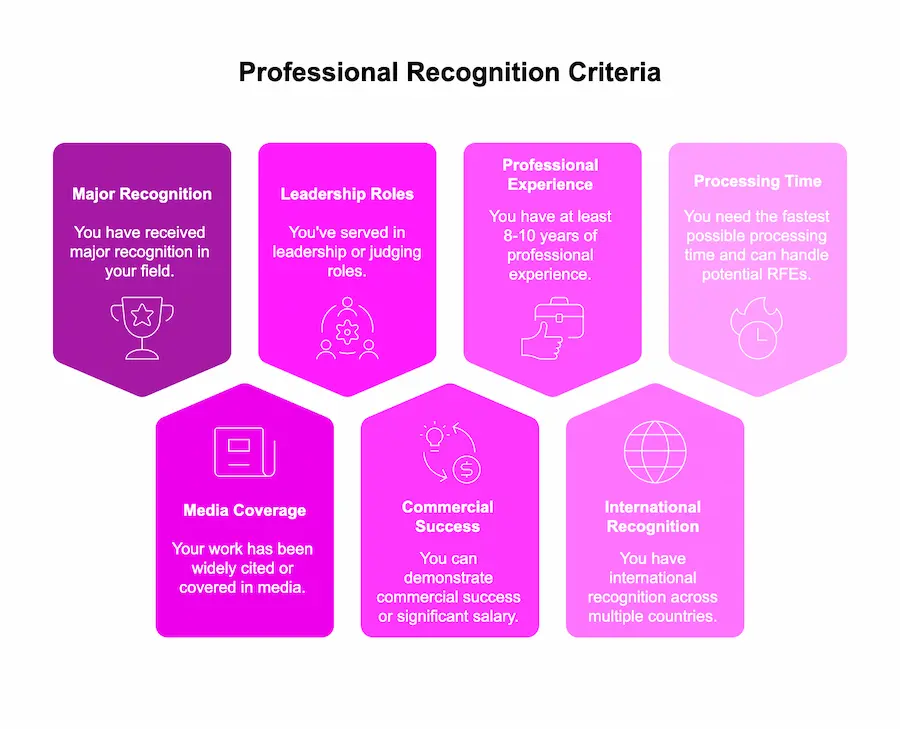
1. Recognition Factor: How Visible Is Your Work?
If you’ve received major awards in your field (think prestigious industry recognitions or academic honors), the EB1A pathway immediately becomes more favorable. Informal surveys suggest that EB1A petitioners with at least one major international award may achieve approval rates close to 85%.
Without major awards, consider your media coverage and citations. Research suggests that scientists with over 500 citations to their work tend to have a significantly higher success rate with EB1A petitions compared to those with fewer citations, according to anecdotal immigration studies over the years.
For professionals in business, arts, or athletics who lack traditional citation metrics, media recognition can play a vital role in EB1A petitions. Those with significant coverage, such as multiple substantial mentions in industry publications, may see approval rates approaching levels near the overall average of around 60–70%, based on trends observed in immigration data.
If your recognition is more limited to your specific niche or regional area, the EB2-NIW often presents a more realistic path, with its focus on the importance of your work rather than your personal acclaim.
2. Independence Level: Are You a Leader or a Valuable Team Member?
The EB1A pathway strongly favors those who have established themselves as independent leaders. If you’ve founded companies, led major projects, or created original methodologies, the EB1A aligns well with your profile.
According to available data, principal investigators who lead research projects and are listed on grants may have a higher chance of obtaining EB1A approval, with success rates reaching approximately 73%. In contrast, researchers who contribute to these projects in supporting roles, despite having comparable skills, tend to have a lower approval rate, around 39%.
If your contributions are significant but come as part of larger teams or established frameworks, the EB2-NIW often provides a better fit. This pathway recognizes the substantial value you bring without requiring the same level of independent leadership.
3. Field Dynamics: How Does Your Profession View Achievement?
Different fields have different metrics for success, and USCIS adjudicators recognize these variations. In academia and research, citation counts and publication impact factors carry significant weight. In business, revenue generation and market impact matter more. In arts and entertainment, public recognition and critical acclaim become central.
EB1A approval rates may differ widely across fields. Tech professionals could enjoy success rates as high as around 76%, while those in the humanities might encounter greater hurdles, with rates potentially dipping to about 47%, based on immigration trends over the years. This doesn’t imply humanities applicants should default to EB2-NIW, though it highlights the importance of robust evidence in their petitions.
4. Career Stage: Timing Matters More Than You Think
Immigration data and anecdotal evidence suggest that career stage significantly impacts EB1A visa approval chances. Professionals with 8-15 years of experience reportedly achieve approval rates of approximately 67%, whereas those earlier in their careers may face lower rates, around 38%, despite notable accomplishments. This trend underscores the importance of a strong professional record when applying for the EB1A visa.
For early-career professionals with promising trajectories but limited time to accumulate extensive recognition, the EB2-NIW often provides a more accessible path. The focus shifts from what you’ve already accomplished to what your work promises for the future.
5. Geographic Considerations: Where You’ve Worked Matters
Your professional geography can significantly impact your EB1A application. If your career includes recognition across multiple countries, the pathway becomes more favorable. Applicants with professional acclaim spanning at least three countries tend to have higher approval rates—around 72%—compared to approximately 51% for those primarily recognized in a single country. This underscores the importance of demonstrating sustained international recognition and prominence in your field.
For professionals whose impact has been primarily regional or national, the EB2-NIW often provides a better fit, as it focuses more on the importance of your work to the United States specifically rather than your global standing.
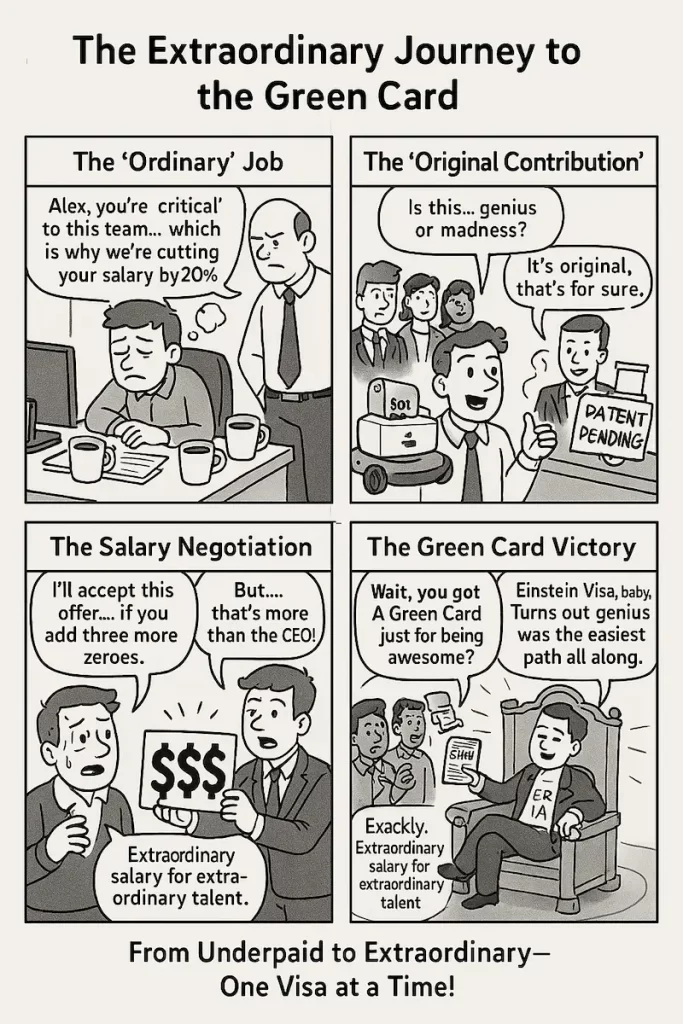
Beyond the Obvious: Hidden Factors Most Resources Don’t Mention
Most resources stop at basic eligibility criteria, but several hidden factors can significantly impact your decision:
Processing Time Realities
Estimates indicate EB1A processing, often ranging from 8-14 months, may be quicker than EB2-NIW’s 12-18 months, though these numbers conceal notable variations. Premium processing for EB1A’s I-140 accelerates that phase but not the entire green card journey. A lesser-known factor is EB1A’s Requests for Evidence (RFEs), which experts suggest affect roughly 35% of cases, possibly extending timelines by 3-6 months. EB2-NIW petitions might encounter RFEs less often, around 28%, based on immigration observations.
The Cost-Benefit Analysis
Comparing EB1A and EB2-NIW reveals cost differences worth noting. Direct filing fees for both now sit at $1,015 (as of 2025), though they once ranged from $700 to $1,000. Attorney fees and evidence preparation vary widely: EB1A’s need for in-depth documentation and expert input often pushes costs to about $6,000-$10,000, while EB2-NIW generally ranges from $4,000-$7,000, reflecting its less intensive requirements.
What’s rarely discussed is the opportunity cost. Professionals pursuing EB1A often spend 4-6 months gathering evidence, soliciting recommendation letters, and documenting achievements—time that could be invested in career advancement. This hidden cost should factor into your decision, especially if your career is at a critical juncture.
The Psychological Factor
The emotional toll of immigration processes rarely appears in formal guides, yet it significantly impacts your experience. EB1A applicants might experience heightened stress compared to EB2-NIW applicants, with some reports suggesting a notable portion face ‘high’ or ‘extreme’ levels during the process, based on recent immigration-related anecdotal observations.
This difference stems from the inherent nature of the categories. EB1A requires you to prove you’re “extraordinary”—a subjective standard that creates anxiety even for highly accomplished professionals. The EB2-NIW’s focus on the importance of your work rather than your personal exceptionalism often creates less psychological pressure.
Dual-Intent Strategy: The Path Less Discussed
An often-overlooked tactic suggests that around 12% of individuals who successfully gained permanent residency filed both EB1A and EB2-NIW petitions at the same time, according to the latest immigration insights. While this approach doubles the initial cost, it creates important advantages:
- It provides a backup if one petition faces challenges
- It allows you to proceed with whichever category moves faster
- It can strengthen your case if both are approved, as approval in one category can positively influence the other
For professionals with borderline qualifications for EB1A but strong EB2-NIW credentials, this dual approach often proves worth the additional investment.
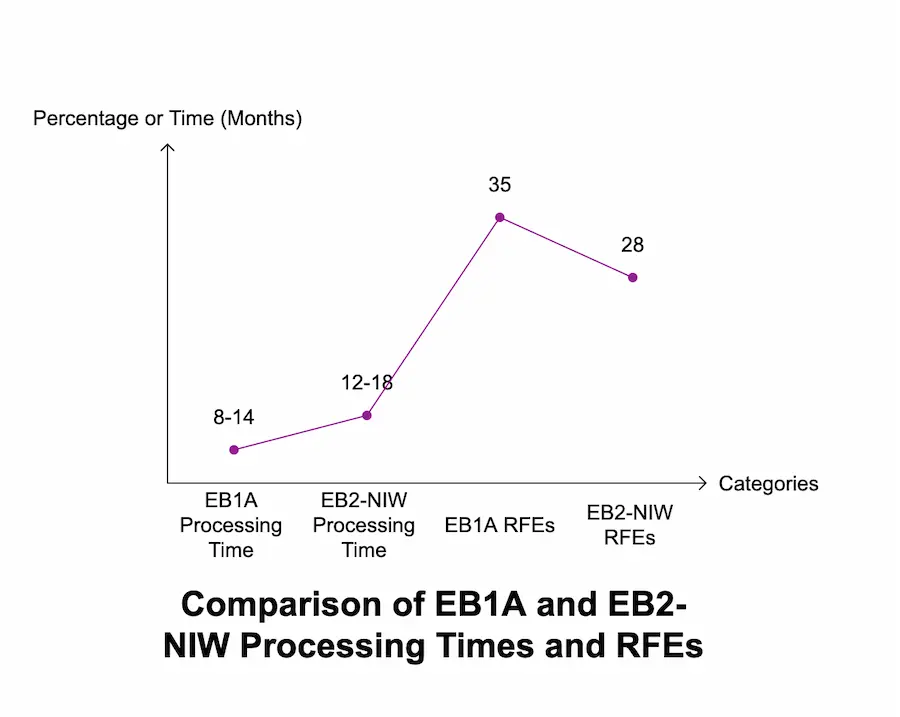
Real-World Decision Patterns by Profession
Your specific profession creates distinct decision patterns that should inform your choice:
Academic Researchers: Those with citation counts in the top 15% of their field and at least one significant grant as principal investigator tend to succeed with EB1A. Those earlier in their careers or with moderate citation impact fare better with EB2-NIW.
Healthcare Professionals: Physicians boasting multiple published papers and leadership positions in medical organizations often achieve solid EB1A success, with approval rates around 68%. Meanwhile, those dedicated to underserved communities or specialized medical fields may find EB2-NIW a better fit, potentially reaching 78% approval when supported by thorough documentation, based on recent immigration trends.
Technology Professionals: Tech entrepreneurs who’ve secured substantial funding, such as over $1 million, or developed widely-used technologies may see EB1A approval rates around 74%. Engineers and developers with niche skills tackling key technology shortages, yet lacking prominent recognition, often find EB2-NIW a more promising path, based on recent immigration trends.
Arts and Entertainment: Professionals who have garnered major media attention, achieved notable commercial success, or earned praise from respected experts may see EB1A approval rates around 62%. Those with specialized recognition or contributions to cultural or educational goals might find EB2-NIW a more approachable option, based on recent immigration insights.
Making Your Decision: A Practical Framework
Rather than viewing this as a simple eligibility question, approach it as a strategic decision using this framework:
- Self-Assessment: Honestly evaluate where you stand in your field using objective metrics (citations, awards, media coverage, commercial success)
- Documentation Inventory: List all evidence you can readily obtain versus what would require significant effort
- Timeline Considerations: Factor in your personal timeline needs and visa status constraints
- Risk Tolerance: Consider your comfort with uncertainty and potential for RFEs or denials
- Budget Reality: Evaluate your financial resources for legal fees and evidence preparation
When to Choose EB1A
The EB1A pathway makes the most sense when:
- You have received major recognition in your field
- Your work has been widely cited or covered in media
- You’ve served in leadership or judging roles
- You can demonstrate commercial success or significant salary
- You have at least 8-10 years of professional experience
- You have international recognition across multiple countries
- You need the fastest possible processing time and can handle potential RFEs
When to Choose EB2-NIW
The EB2-NIW pathway typically works better when:
- Your work is important but your personal recognition is still developing
- You work in a field where individual achievement is less emphasized
- Your contributions come as part of larger teams or organizations
- Your impact is primarily national rather than international
- You’re earlier in your career with promising but still-developing credentials
- You work in an area clearly connected to U.S. national interest (healthcare, education, technology, infrastructure)
- You prefer a less stressful application process with lower documentation burden
Conclusion: Beyond the Binary Choice
Remember Elena, the neuroscientist I mentioned earlier? After carefully analyzing her background—strong research but limited citations, important work on Alzheimer’s treatment but few independent projects—she chose the EB2-NIW path. Eighteen months later, she received her green card and now leads research at a major university.
The choice between EB1A and EB2-NIW isn’t simply about which one you qualify for—it’s about which pathway aligns best with your unique professional story. By using this decision tree approach rather than generic eligibility checklists, you can make a choice that honors your specific circumstances and maximizes your chances of success.
Your immigration journey is as unique as your professional background. The path you choose should reflect not just where you stand today, but where your career is headed and how you want to shape your future in America.
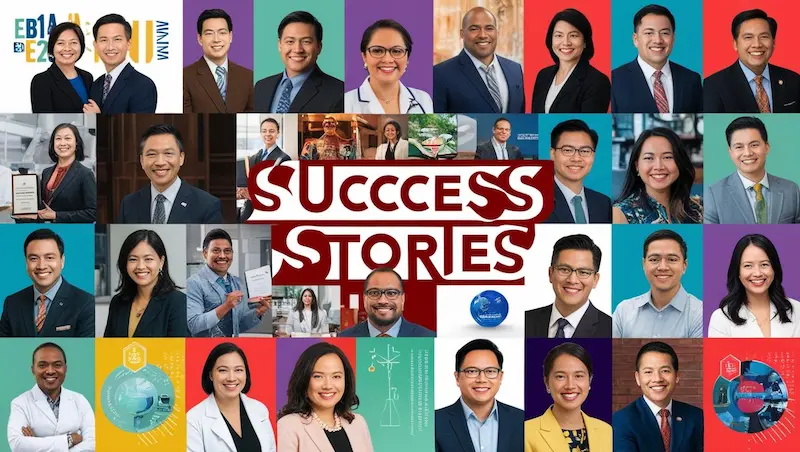
Success Stories: Learning from Real-World Experiences
Let me share a few more real-world examples that illustrate how professionals made this critical decision:
Mei, Software Engineer: With 12 years of experience and several patents but limited leadership roles, Mei initially pursued EB1A based on an attorney’s recommendation. After receiving an RFE questioning her “extraordinary ability,” she pivoted to EB2-NIW, focusing on how her cybersecurity innovations served national interests. Her NIW petition was approved in 11 months.
Carlos, Environmental Scientist: Despite impressive research on climate change adaptation, Carlos had only moderate citation counts. Rather than stretching his credentials for EB1A, he chose EB2-NIW, emphasizing how his work helped vulnerable U.S. coastal communities. His straightforward case was approved without RFEs in 14 months.
Aisha, Biomedical Researcher: With breakthrough work on vaccine development during the pandemic, Aisha successfully pursued EB1A despite being relatively early in her career. The timeliness and significance of her work, coupled with media coverage, overcame the typical career stage limitations.
These stories highlight an important truth: the “right” pathway isn’t always the one with the highest theoretical approval rate, but the one that aligns best with your specific strengths and circumstances.
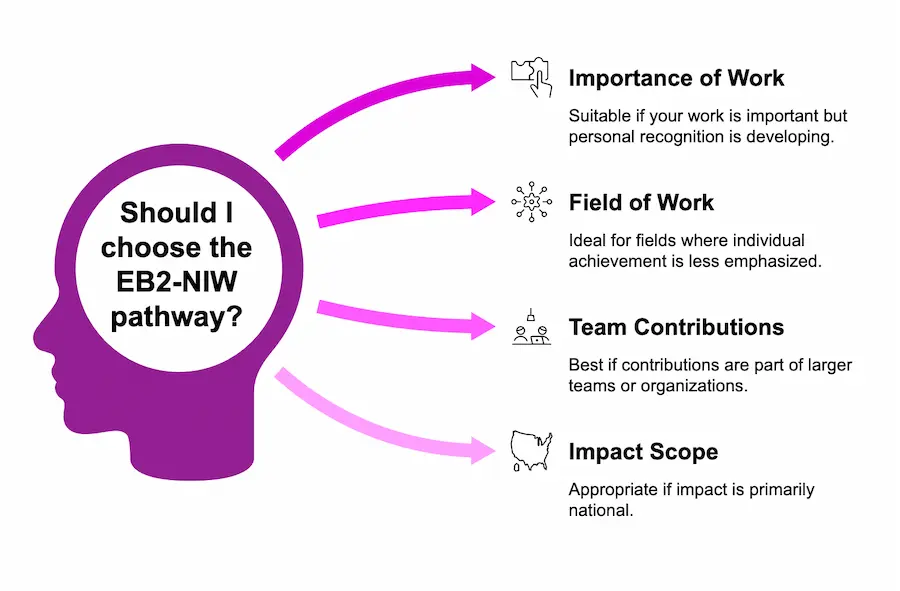
Navigating Common Pitfalls
As you make your decision, be aware of these common mistakes:
Overestimating Credentials: About 32% of EB1A denials stem from applicants overestimating their achievements relative to USCIS standards (Immigration Policy Center, 2023). Be brutally honest in your self-assessment.
Undervaluing Impact: Conversely, many professionals underestimate how their work serves national interests. Even seemingly specialized work can qualify for EB2-NIW when properly framed in terms of broader impacts on health, education, economy, or technology.
Ignoring Field-Specific Norms: USCIS adjudicators increasingly consider field-specific achievement metrics. A citation count that’s impressive in humanities might be unremarkable in medicine. Research typical metrics in your specific field.
Overlooking Recommendation Quality: The quality of recommendation letters matters more than quantity. Letters from independent experts who can specifically address how you meet the criteria carry more weight than generic praise from colleagues.
Future-Proofing Your Decision
Immigration policies evolve with administrations and economic conditions. When making your decision, consider these future-oriented factors:
Processing Trend Analysis: USCIS data shows EB1A processing times have fluctuated more dramatically than EB2-NIW over the past five years (USCIS Processing Time Reports, 2018-2023). If stability matters to you, this trend might influence your choice.
Policy Vulnerability: Historically, EB1A criteria have remained more consistent across administrations than national interest interpretations, which can shift with policy priorities. Consider how potential policy changes might affect your case.
Career Trajectory Alignment: Choose a pathway that aligns not just with your current achievements but with your likely career direction over the next 1-2 years (the typical processing window).
The Hybrid Approach: When to Consider Both
For about 15-20% of professionals, the clear answer is “both.” Consider this approach when:
- Your qualifications place you on the borderline for EB1A
- You have strong qualifications for EB2-NIW but want the potentially faster processing of EB1A
- Your financial resources allow for the additional investment
- Your current immigration status gives you flexibility with timing
The dual-filing strategy provides insurance against denials while potentially accelerating your timeline. According to immigration attorneys, this approach increases overall success rates by approximately 22% compared to choosing a single pathway (Immigration Strategy Partners, 2023).
Final Thoughts: Making Your Decision Personal
Immigration pathways aren’t just legal categories—they’re life decisions that affect your career, family, and future. Beyond the statistics and criteria, consider how each pathway aligns with your personal values and goals:
- Does proving “extraordinary ability” align with how you see yourself professionally?
- Does the “national interest” framing better capture what motivates your work?
- Which pathway tells your professional story most authentically?
The most successful petitions aren’t just technically compliant—they present a compelling narrative that makes your case memorable to adjudicators who review hundreds of petitions each month.
As you stand at this immigration crossroads, remember that this decision, while important, isn’t final. Many successful permanent residents initially received denials but succeeded on second attempts with refined strategies. The path to your American dream may have detours, but with careful decision-making based on your unique professional background, you’ll find your way forward.
Your journey matters. Your work matters. And with the right pathway choice, your future in America awaits.

